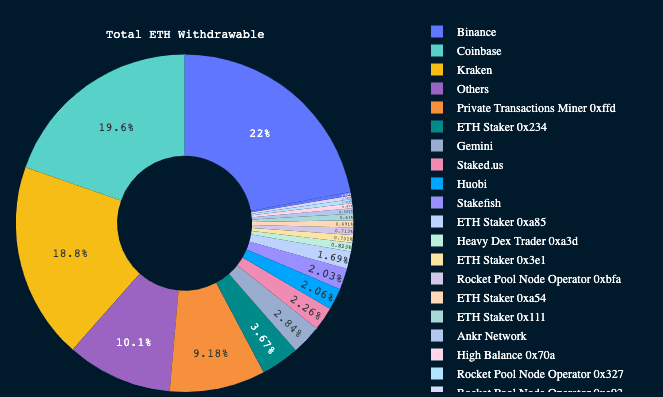How it works after the Shapella upgrade
3 min readMany had predicted a big sell-off at Ethereum in the course of the Shanghai upgrade (later Shapella). Because investors got access to staked ETH worth around 37 billion US dollars for the first time since 2020. The large amount of unlocked coins would lead to massive price turbulence, it said. So far, however, the disaster has not materialized. A look at the on-chain data (according to Nansen) shows why: currently only 4.5 percent of withdrawable coins are waiting to be paid out. Or to put it another way: more than 95 percent of stakers do not want to get rid of their coins for the time being.
Central crypto exchanges are losing
Every ETH staker who wants to withdraw their stake plus rewards from Ethereum’s staking mechanism first gets into a queue. This can be used to determine where the (so far minimal) withdrawals come from. Here it becomes clear: It is mainly central crypto exchanges that withdraw their coins. And probably not even voluntarily.

Until recently, Kraken was responsible for the bulk of these withdrawals, now superseded by Binance and Coinbase. All three got to the authorities in the USA this year. As a result, Kraken was forced to shut down its staking services by order of the SEC. The harsh course of Gary Gensler’s agency is showing its aftermath here. Binance and Coinbase also appear to be taking precautionary measures and withdrawing their stake due to this regulatory uncertainty.
And if not the exchanges themselves, then their customers are increasing. Because decentralized staking providers have been gaining new users in the past few days. This suggests that customers of the exchanges are moving their coins from their staking services to protocols such as Lido, Rocket Pool or new, decentralized alternatives such as Ether.fi.
No “staking escape”
The data points to a healthy development of the Ethereum staking landscape. Users are increasingly recognizing the regulatory risk of staking on central crypto exchanges and are putting their trust in decentralized alternatives. There is also a higher yield there. The Shapella upgrade has obviously increased trust in Ethereum. This is also shown by the fact that validators, apart from a few days, deposit more net than they withdraw.

The initial surge in payouts further shows that validators mostly deducted their rewards (marked yellow in the image) but not their entire stake (blue in the image). There seems to be no reason for them to retire from staking altogether. For many stakers, it was arguably more about securing long-locked rewards.
In some cases, full payments are still made. So far, however, these have only made up a small proportion of what remains on the chain. In addition, some of the exchanges mentioned above are shutting down their services or users are switching their entire stake from one service to another. Such flare-ups are therefore likely to decrease over time.
Cancun upgrade on the horizon
Ethereum is now a full-fledged proof-of-stake blockchain. After the upgrade, users have absolute certainty that they will get their coins back (plus interest) after staking. This should ensure a new rush of stakers. Namely, currently just under 15 percent of all possible ETH coins. With competitors like Cardano or Solana it is between 60 and 80 percent. If Ethereum is now also heading for such numbers, the supply in circulation would become significantly scarcer, which in turn could have a positive effect on the ETH course with the same demand.
Meanwhile, developers are already looking at the next upgrade: the Cancun hard fork or EIP-4844. Here everything revolves around the scalability of the blockchain, which is driven by “proto-thanksharding”. The network load is divided between individual sidechains such as Arbitrum and Optimism, which are optimized in the same breath. Ethereum’s Layer 2 solutions could become 20x cheaper and faster as a result. Developers are planning EIP-4844 for the third quarter or quarter of this year, barring any delays.






